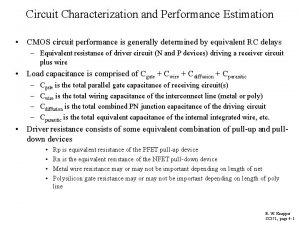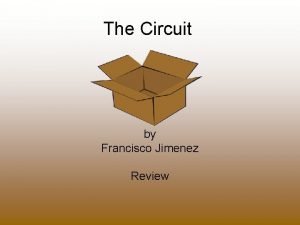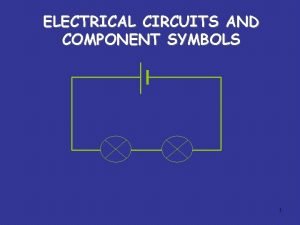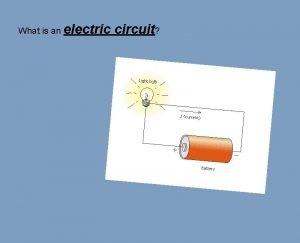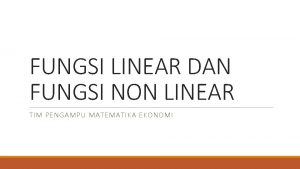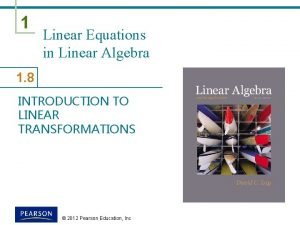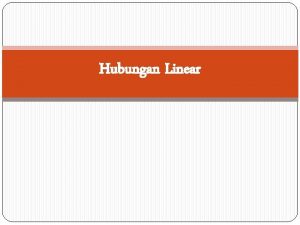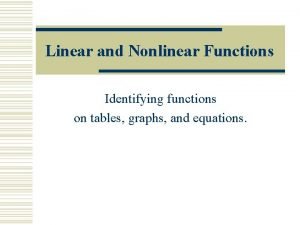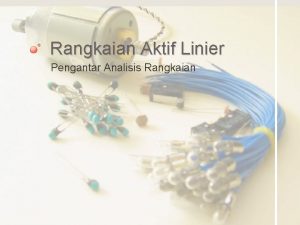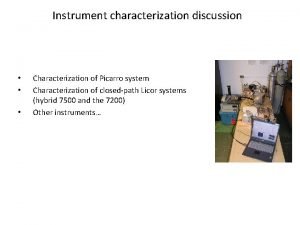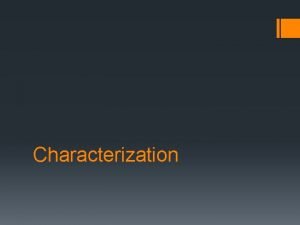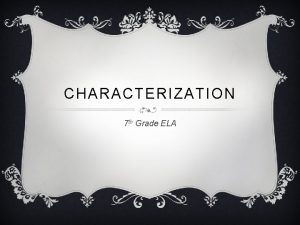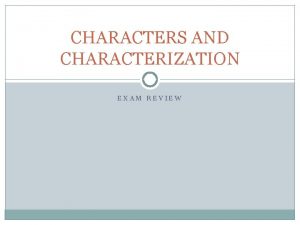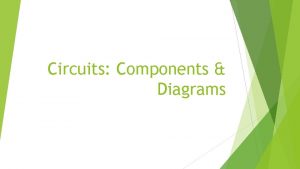4 Circuit Characterization Contents 1 Linear Circuit Components




























































- Slides: 60

4 Circuit Characterization Contents 1. Linear Circuit Components ; R, L & C 2. Dominant Components in each w-region(delay, voltage drop) 3. inverter DC & delay characteristics 4. R & C Model for MOSFET’s & wires MOS(internal) device capacitance Diffusion(external device ; source/drain) capacitance Routing capacitance, resistance 5. Gate delay input slope series-connected(stacked) MOSFET configuration : Penfield-Rubinstein model inverter stage ratio 1

6. CMOS용 inverter & Power dissipation Static dynamic Short-circuit Ring counter 7. High-Current Effects Power/Ground bounce EM/ESD/EOS(Electro-migration/Electro-Static Discharge/Electrical Over. Stress) 2

1. Linear Circuit components : R, L & C v i. R q Resistance CR) : i R v V i=qv V Velocity Saturation t t : mean time between collision 3

q Capacitance(C) : V i v 1 C v 2 q Inductance(L) : V w. L i + v - i 4

2. Dominant components V=Z • i (z = impedance) Z(w) w. L 1) region I : C dominates 2) region II : R dominates R 3) region III : L dominates II I w wc III w. L 5

3. Inverter DC & delay characteristics 1 1 0 0 load 0 seesaw rope seesaw 2 foods seesaw balance rdendez-vous seesaw q Role of inverter : 1. Signal buffering/transmission 2. Logic function 6

q Inverter is composed of driver and load driver(transistor) characteristics Load characteristics linear triode VGS 4(8 V) i 1 i 2 VGS 3(6 V) VGS 2(4 V) VGS 1(2 V) VDS D G i 1 S out in V 12 1 i 2 RL 2 7

q Putting them together, KCL(Kirchoff’s Current Low) demands i 1=i 2 VDD RL Vi i i I= Vo (Vo-VDD) Vi Vo VDD <Output Characteristics> <Transfer Characteristics> Vo Ideal RL increase Vi 8

q Resistor, as a passive load, requires large silicon area. RL(10 K ) = 100 R (100 / ) Active load is better for digital purposes. VDD Large area (100 s) Vo Vi GND 9

q Problems with Enhancement load 1. Slow charge/discharge due to small load current especially when Vo VDD 2. Vo cannot be raised higher than VDD-VT’ (VT’ : threshold voltage considering body effect) Vi = 5 V Q 1 : Static load line Dynamic load line Q 2 A B Vi = 0 V VDD-VT VDD 10

i) Static Load Line : i. L = i. D VDD ii) Dynamic Load Line(due to load capacitance, CL) i. L charging(Q 1 Q 2) ; Vo Vi i. D = i. L - CL discharging(Q 2 Q 1) ; i. D = i. L + Magnitude of average charging/discharging current is given as the area of AQ 1 Q 2 B 11

q How to improve Inverter speed is how to increase charge/discharge current. n Sol. 1. Bootstrap method VDD I Vi=5 V T 1 X T 2 Dynamic load line (due to CX) Vo CX Vi Q 1 T 3 Q 2 Q 3 Vi=0 V Static load line VDD-2 VT VDD VO 12

n Sol. 2 Depletion load method Depletion Enhancement ID element ID VTD<0 - VG=0 V VG=-1 V VTD>0 0 Depletion type VG=2 V VG=-2 V VG=2 V + VG VDD VG=1 V VG=0 V Enhance -ment type Question) Why cannot one use depletion MOSFET as a logic element ? 13

VDD i. L Vi Vo Vi=5 V i. D i. L=b(-VTD)2 i. D Vi=0 V VDD body 효과를 고려한 부하선 VDS(=V 0) q Gate and Source terminals of Depletion device is tied together to suppress the Vo-dependence of i. L, i. e. , i. L=b(0 -VTD)2= b VTD 2, acting like a constant current source. 14

q Speed comparison between R, E, D-load VDD i t=0 C Eq. (1) Eq. (2) VDD R D R i Eq. (3) VDD 0. 6 R D’ E Charging time vs. voltage 0. 8 VDD 15

eq(1)를 invert & integrate 한 curve dt C = d. V i eq(2) t dt d. V E R t 0 VDD+VTD=0. 4 VD eq(3) D’ VDD-VTE=0. 8 VD Output voltage, V 16


E-load : VDD i. E(v) v -1 C eq. (2) D-load : 0. 4 VDD<V<VDD에서는 0. 6 R의 저항을 통한 충전 : eq. (3) 18

q Inverter delay( ) 정의) = 한 inverter가 같은 size의 연결된 inverter의 입력전압을 방전시 키는 시정수 SW 1 Cg RL RL k SW 2 RD Cg Cg RD Cg RL : depletion 소자 등가저항 RD : driver의 등가저항 ; inverter ratio = q inverter ratio k is determined as 4, from the following static consideration 19


q Effective load capacitance, CL = CS+ Cgs +2 Cgd >> Cg m. Cgd Cs Av: inverter 전압이득 m=1 -Av Cgs q Miller capacitance A DV Cgd B Av DV (1 -Av) DV ; effective voltage change Effective capacitance = Total charge change input voltage change Miller factor For digital inverter (1 -Av) => 2 21

4. R & C Models for MOSFET’s & wires Transistor as R 22

MOSFET Capacitance MOSFET: 4 -terminal device i) Gate capacitance off G non-sat. (short-channel) 0 0 CGB CGS CGD D S CDB CSB B CGS 0 CGD 0 CG(total) 0 CGB CG=CGS+CGD+CGB 2/3 CGS 0. 5 C [COX] CGD off sat. lin. CGB VGS 23

MOSFET parastic capacitance(=junction cap. +overlap cap. ) 24

ii) Junction capacitance Sidewall junction is more abrupt 25

iii) Overlap capacitance(due to lateral diffusion) 26

Capacitance, Conductance values(typical) for SPICE 27

iv) Routing Capacitance Csw Cf t Cp S Csw Cp: fringing cap. Csw: sidewall cap. W Cp: planar cap. Cp Assume t=const Cf W(=S) For high-(t/w), multi-bit bus, Csw dominates. 28

q Distributed RC line R Vj-1 R C Vj C R Vj+1 R C R = r dx (r: resistance per length) C = c dx(c: capacitance per length) : Diffusion equation (tx : time for propagating distance x) 29

q Frequency domain solution of the distributed RC line to unit step input is as cosh(x) = 30

q Distributed vs. Lumped R R C (Distributed) C (Lumped) Vout Time elapsed D L time Distributed Lumped 0 - 90% RC 2. 3 RC 0 - 63% 0. 5 RC RC 0 - 10% 0. 1 RC 31

q Characteristic of Diffusion : tx kx 2 t=1 t=4 t=9 t=16 0 1 2 3 1 mm 4 x 1 mm For t =4 10 -15 2[ in m] I) with buffer tp = 8 ns + buffer ii) without buffer tp = 16 ns 32

5. Gate Delay q t. T = t. D + ti + tslew, tslew = rslew CL t. D : internal delay of the cell ti = delay due to the intrinsic output capacitance rslew : output slew rate [ns/p. F] CL : load capacitance for each output input t. D output Ex. t. Q=1. 39+0. 83+1. 63 CL tslew ti t. D = t. D, O Kt Kv Kp KV Kt 3. 0 3. 3 3. 6 VDD -30 RT +90 process Kp Slow 1. 34 typ. 1. 00 fast 0. 72 33

q input slope dependence (n = , : input rise time) (p = , : input fall time) 34

q Series-connected(stacked) MOSFET Configuration Penfield-Rubinstein model : C 4 A N 4 B N 3 C N 2 C 2 D N 1 C 1 : Summed resistance from i to power/ground : Capacitance at point i td = R 1 C 1 + (R 1+R 2)C 2 + (R 1+R 2+R 3)C 3 + (R 1+R 2+R 3+R 4)C 4 = R 1(C 1+C 2+C 3+C 4) + R 2(C 2+C 3+C 4)+R 3(C 3+C 4)+R 4 C 4 Elmore delay model 35

q Elmore delay TAB = R 1(C 2+C 3+C 4 +C 5 +C 6 +C 7 +C 8 +C 9 +C 10) +R 2( +C 3+C 4 +C 5 + C 6 +C 7 +C 8 +C 9 +C 10 ) +R 3( +C 4 +C 5 + C 6 +C 7 +C 8 +C 9 +C 10) TBD = R 4( +R 7( +C 7 +C 8 +C 9) TBE = R 5( +R 6( +C 6 +C 10) 36

q Delay Modelling i) 50%-50% delay : for multiple levels of static logic circuit 37

ii) 10%-90%(90 -10) delay : rise time(fall time) : for precharged dynamic circuit 38

q Delay model of interconnection driven by Rtr & terminated by CL Rtr Rint Cint T 90% = 1. 0 Rint Cint + 2. 3(Rtr. Cint+ Rtr. CL+ Rint. CL) CL 39

q Inverter Stage Ration Driving large C load using graded inverter chain 1 f f 2 f. N Cg CL Q. Determine the scale-up factor, f minimizing total delay time for driving CL from Cg 40

A. mumber of inverters, N is given by = Y, i. e. , N= Total delay is Nf , which is to be minimized. Total delay = = * In real situation, f could be much larger than 2. 7 to reduce the chip area consumption 41

6. CMOS Inverter & Power Dissipation VDD G S q Static Transfer Characterictic D Vi I G D S C VDD A B D E Vo 0 VTN VDD 2 VDD V i VDD- VTD PMOS Vo NMOS (VSS or GND) NMOS PMOS Region A cutoff linear Region B sat linear Region C sat Region D linear sat Region E linear cutoff Static power dissipation 42

q Adjustment of VTN, VTP i) VTN + VTP < VDD-VSS : static current flows ii) VTN + VTP = VDD-VSS : ideal case iii) VTN + VTP > VDD-VSS : hysteresis PMOS VTN 0 VTN NMOS Vi VTP V DD Both are off Vi VDD-VTP Vo Vo Vo Vi 43

q Influence of PN asymmetry on the transfer characteristics Vo 10 0. 1 Vi VDD infinite transfer gain ideal zero output conductance 44

q Power Consumption i) dynamic power dissipation Vi Vi Substituting, Vo t=0 Vo and (f : switching frequency) eq. (1. 11) 45

q Energy stored in CL charged up to VDD is from eq. (1. 11), switching energy consumed per cycle is where did go ? 46

q Modelling of resistive dissipation in ideal switch replace MOSFET by ideal switch in serial with a resistance, R i) In Vo’s going up ; R i Vo (indep. of R!) ; energy dissipated R in R as Vo is being raised from 0 to VDD 47

ii) In Vo’s going down R R i lose 1/2 store 1/2 R lose 1/2 Energy dissipated in R as CL is being discharged GND 48

iii) Short-circuit dissipation ref. H. J. M. Veendrick, “Short-circuit dissipation of static CMOS…” IEEE J. Solid-state Circuits, Vol. SC-19, Aug, 1984. Pp 468 -473 assumption: CL = 0 Vi VDD T r f VDD-|VTP| VDD/2 VTN Vi i Vo i imax (A) (B) iav t=0 t 1 t 2 t 3 49

q For simplicity, assume , t = tr = tf and VT = VTN = -VTP (waveform (A) = waveform(B), (A) is symmetric w. r. t t = t 2 ) setting 50

Short-circuit current waveform with finite CL obtained from SPICE CL=0 200 A CL=200 f. F=2 x 10 -13 F CL=500 f. F ISC CL=1 p. F CL= 0. 8 VDD - |VTP| 2 3 4 CL 5 time(nsec) = n= p=170 A/V 2 Vt=Vtn=|Vtp|=0. 8 V VTN time(nsec) 51

output voltage CL=1 p. F CL=0 CL=500 f. F time(nsec) PT=Pdyn+ PSC : input voltage rise time =20 ns ln PT =10 ns total dissipation(PT) =5 ns For a load capacitance C*, = 5 ns in near optimal input transient =1 ns dynamic dissipation limit ln C* ln CL Pdyn PSC (sec) 52

C) Ring counter for measuring gate delay VDD i 1 C Cg i 1 d V 1 i 2 C i 3 C V 2 i 2 d i 3 d V 3 i 4 C i 4 d V 4 i 5 C V 5 VO i 5 d I 53

g i 1 C i 2 C i 3 C i 4 C i 5 C T g = T / N i 1 d i 2 d i 3 d i 4 d i 5 d 2 g Total discharge current at I-meter Power-delay product per gate =energy consumption per switching=QVDD=Cg. VDD 2=(VDDIDCT/N)*2 54

7. High-current Effects q Electro-migration: directional movement of charge carriers(DC current) – causes deformation, breakage of conductor, occurs at the constriction point. – ex) fuse(positive use of EM effect) depending on current density, temperature, and crystal structure limiting current: 2 m. A/ m 2 – rule of thumb: use 0. 4 -1. 0 m. A/ m 2 for VDD & VSS 55

q Power & Ground Bounce temporary level change in the power and ground voltage due to sudden change of charging/discharging current called simultaneous switching noise, DI-noise, d. I/dt noise due to i. R and/or L di/dt drop in the power/ground rail originates from large current drivers such as clocking buffer, I/O buffer 56

q Power-distribution path in IC and the electrical model 57

q Simplified electrical model of a CMOS chip 58

8. Technology scaling(Constant E-field scaling) 59

 Definition for direct characterization
Definition for direct characterization Indirect characterization example
Indirect characterization example Distributed rc delay model
Distributed rc delay model Panchito the circuit
Panchito the circuit Disadvantages of berlo's model of communication
Disadvantages of berlo's model of communication Symbols for some electric circuit components
Symbols for some electric circuit components Circuit components symbols
Circuit components symbols Simple linear regression and multiple linear regression
Simple linear regression and multiple linear regression Contoh soal biseksi
Contoh soal biseksi Different types houses
Different types houses Non linear plot examples
Non linear plot examples Non linear simultaneous equations
Non linear simultaneous equations Linear pipeline
Linear pipeline What is the meaning of table of content
What is the meaning of table of content Define left linear grammar
Define left linear grammar Contoh soal fungsi non linier
Contoh soal fungsi non linier Penerapan fungsi non linier dalam ekonomi
Penerapan fungsi non linier dalam ekonomi Do linear transformations preserve linear independence
Do linear transformations preserve linear independence Linear algebra linear transformation
Linear algebra linear transformation Rumus dwi koordinat
Rumus dwi koordinat Linear impulse
Linear impulse Penyelesaian persamaan simultan
Penyelesaian persamaan simultan Non linear table
Non linear table Nonlinear tables
Nonlinear tables Differences between linear and nonlinear equations
Differences between linear and nonlinear equations Nonlinear video editing
Nonlinear video editing Persamaan linier 1 variabel
Persamaan linier 1 variabel Right linear grammar
Right linear grammar Textos narrativos para copiar
Textos narrativos para copiar Sinusoidally excited linear circuit
Sinusoidally excited linear circuit Rangkaian linier adalah
Rangkaian linier adalah Parallel circuit voltage
Parallel circuit voltage Type of circuits
Type of circuits Phet circuit construction kit
Phet circuit construction kit Series vs parallel circut
Series vs parallel circut Complete and incomplete circuit
Complete and incomplete circuit Short in parallel circuit
Short in parallel circuit Concept map
Concept map Circulatory system labeled
Circulatory system labeled Advantages of parallel circuits over series circuits
Advantages of parallel circuits over series circuits Define career portfolio
Define career portfolio Deep perineal pouch contents
Deep perineal pouch contents Trali symptoms
Trali symptoms Febrile non hemolytic transfusion reaction
Febrile non hemolytic transfusion reaction Mediastnum
Mediastnum Popliteal fossa
Popliteal fossa Superior mediastinum contents
Superior mediastinum contents The immortal life of henrietta lacks table of contents
The immortal life of henrietta lacks table of contents Medial lemniscus
Medial lemniscus Muscles of the scapular region
Muscles of the scapular region Ark of the covenant lampstand
Ark of the covenant lampstand Comic book table of contents
Comic book table of contents Calot's triangle boundaries
Calot's triangle boundaries Mla table of contents
Mla table of contents Stylistic lexicology
Stylistic lexicology Front page of school magazine
Front page of school magazine Continuous variable example
Continuous variable example Example of appendix in report
Example of appendix in report Fresh frozen plasma contents
Fresh frozen plasma contents Occupied
Occupied Pericardial sinuses
Pericardial sinuses


